The Bund is an Anglo-Indian term for the embankment of a muddy waterfront - in Chinese it's referred to as 'Waitan' and on the map it's Zhongshan Donglu (Zhongshan Road East). The Bund is an apt description; between 1920 (when the problem was first noticed) and 1965 the city of Shanghai sank several meters; correction of the problem involved pumping water back into the ground, but the Venetian threat is still there. Concrete rafts are used as foundations for highrises in this spongy mass.
The Bund of Shanghai is a great meeting place for local Chinese and foreigners alike - people stroll up and down in search of vicarious excitement, often provided by street performers or free-marketeers. Pedlars sell anything from home-made underwear to naughty pictures. In the morning, its Taiji (or Taichi Chuan, shadowboxing) and the martial arts exercises on display; at night it is a lovers' lane.
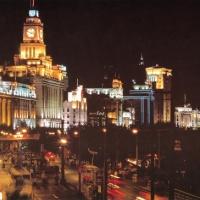
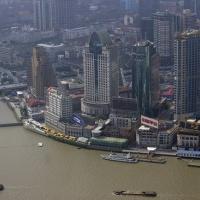
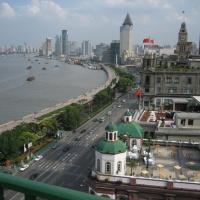
The edifices that line the Bund are considered the international architectural complex. The exteriors are a solemn mix of neo-classical 1930s Chicago with a bit of monumental Egyptian thrown in for good measure. To the Europeans, the Bund was from Shanghai's Wall St, and it saw a fever of trading as the city's fortunes rose and fell with each impending crisis. The buildings changed function several times as the crises got the better of traders, but originally they were banks, trading houses, hotels, residential buildings, commercial buildings and clubs.
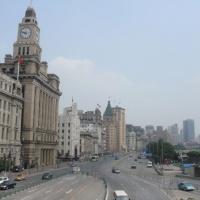 At the northwest end of the Shanghai Bund were, or are, the British Public Gardens (now Huangpu Park) which was off-limits to Chinese during the colonial era - a sign at the entrance listed regulations, which included the prohibition of Chinese and dogs from the park. A Sikh guard stood at the gateway - part of the Indian force the British had brought in to protect themselves after the Boxer Uprising of 1900. Part of the British Consulate grounds has now become the Friendship Store.
At the northwest end of the Shanghai Bund were, or are, the British Public Gardens (now Huangpu Park) which was off-limits to Chinese during the colonial era - a sign at the entrance listed regulations, which included the prohibition of Chinese and dogs from the park. A Sikh guard stood at the gateway - part of the Indian force the British had brought in to protect themselves after the Boxer Uprising of 1900. Part of the British Consulate grounds has now become the Friendship Store.
Whilst the Bund may no longer be full of noisy hawkers, tramcars, Old mobiles, typists, blackmarketeers, sailors, taipans and rickshawmen, its function is still very much the same - only this time it's the foreigners who come to kowtow to the Chinese trading establishments now set up here. There are a few alterations; the Customs House (built in 1927) is still a customs house, but the clock chime now plays "The East is Red' at 6 am and 6 am.
A readily identifiable exterior by the dome on top is the Hong Kong & Shanghai Bank, completed in 1921 and one of the most impressive hunks of granite in colonial Asia. The rowdy RAF Club used to be up in the dome. Today the bank houses the Shanghai People's Municipal Government (City Hall, CCP and PLA HQ) - so there's little chance of seeing the interior.
As for the HK& Shanghai Bank, they have a more modest office now nearing the Bund further north.
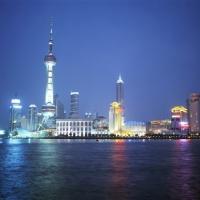 The statues that lined the Bund were stripped, the whereabouts of the pair of bronze lions that once stood outside the HK & Shanghai Bank a mystery. It was first thought that they were melted down for cannons by the Japanese - but later the Chinese claim they found them, and several western sources mention seeing the lions in the early 1970s - possibly brought out for the making of a movie.
The statues that lined the Bund were stripped, the whereabouts of the pair of bronze lions that once stood outside the HK & Shanghai Bank a mystery. It was first thought that they were melted down for cannons by the Japanese - but later the Chinese claim they found them, and several western sources mention seeing the lions in the early 1970s - possibly brought out for the making of a movie.
One interior that you can visit is the Dongfeng Hotel; as you sweep through the double doors, over the marble paving and bump into what looks like a railway concourse, you get and an idea of how the Dongfeng started life - this was the Shanghai Club, the snootiest little gang this side of Trafalgar Square.
Membership was confined to high-brow Brits men only. To the left of the entrance is a Suzhou-style restaurant where you'll find the Long Bar, a 33-meter span of thick wood now hacked into three separate pieces. Opposite was the smoking room, now a Cantonese style restaurant, where doze with their copes of the Times, freshly ironed by the roomboys.
There is a story (another one!) which underlines just how exclusive the Shanghai Club was in 1949; it goes that a westerner was caught in some polite crossfire between Communist and Kuomintang troops along the Bund - he made for the nearest shelter which just happened to be the Shanghai Club. His boss peered out from the window, then opened the door and barked 'You can't come in here. You're not a member'. He eventually let the poor sod in, but only after he'd been proposed for temporary membership.
2010 Shanghai EXPO Tours
4-Day Expo 2010 Shanghai Tour
5-Day Shanghai World Expo 2010 Tour
6-Day Shanghai and Wuzhen Tour
6-Day Expo 2010 Shanghai Huangshan Tour
7-Day China Water Towns and Shanghai Expo Tour
8-Day Shanghai Expo and Suzhou Hangzhou Tour
9-Day Beijng Shanghai Tour
13-Day Beijing Xian Shanghai Tour
14-Day Beijing Tibet Shanghai Tour
14-Day Shanghai Expo Tour
17-Day 2010 China Facts Tour
